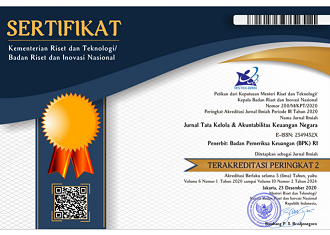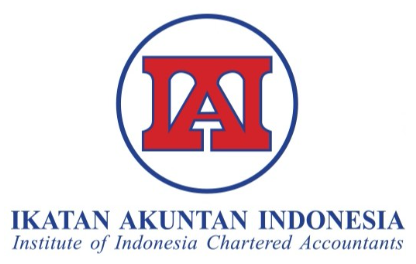Auditee's intention to implement audit recommendations: A qualitative study based on the theory of planned behavior
DOI:
https://doi.org/10.28986/jtaken.v10i1.1404Keywords:
audit recommendations, intention, Theory of planned behaviourAbstract
Previous studies on the implementation of audit recommendations have primarily focused on identifying influencing factors without delving into the specific behaviors of individuals responsible for their implementation. This study aims to analyze auditees' intentions to implement audit recommendations using Ajzen's Theory of Planned Behavior (TPB). While TPB is typically applied with quantitative methods, this research employs a qualitative approach to gain a deeper understanding of respondents' attitudes, motivations, and values. The findings reveal five main themes that influence auditees' intentions to implement audit recommendations: lack of engagement, unorganized organizational pathways, the role of decision-makers or policymakers, mutual reluctance toward coordination, and gaps in knowledge and qualifications. Addressing these themes simultaneously is essential for the effective implementation of audit recommendations. Auditees' attitudes toward implementing audit recommendations significantly impact their intentions. However, subjective norms and perceived behavioral control can pose barriers, diminishing their commitment to the implementation process. This nuanced understanding of the factors affecting auditee behavior is crucial for developing strategies to enhance compliance with audit recommendations.
References
Aikins, S. K. (2012). Determinants of auditee adoption of audit recommendations: Local government auditors’ perspectives. Journal of Public Budgeting, Accounting & Financial Management, 24(2), 195-220. https://doi.org/10.1108/jpbafm-24-02-2012-b002
Ajzen, I. (1991). The theory of planned behavior. Organizational Behavior & Human Decision Processes, 50(2), 179–211. https://doi.org/10.1016/0749-5978(91)90020-T
Ajzen, I., Fishbein, M., Lohmann, S., & Albarracín, D. (2018). The influence of attitudes on behavior. In D. Albarracin & B. T. Johnson (Eds.), The handbook of attitudes, volume 1: Basic principles (197-255). Routledge.
Bale, S., & Pillay, A. (2021). Impact of employee engagement on performance at a pump supplier. International Journal of Multi-Discipline Science (IJ-MDS), 4(1), 510-515. https://doi.org/10.26737/ij-mds.v4i1.1673
BPK RI. (2017). BPK Regulation Number 2 of 2017 concerning Monitoring the implementation of follow-up recommendations on audit results of the Audit Board of the Republic of Indonesia (Peraturan Badan Pemeriksa Keuangan Republik Indonesia Nomor 2 Tahun 2017 tentang Pemantauan Pelaksanaan Tindak Lanjut Rekomendasi Hasil Pemeriksaan Badan Pemeriksa Keuangan). https://peraturan.bpk.go.id/Download/20441/Peraturan%20BPK%20Nomor%202%20Tahun%202017.pdf
BPK RI. (2019). Kajian tindak lanjut atas rekomendasi hasil pemeriksaan. Sub Direktorat Litbang Pemeriksaan Kinerja BPK RI.
BPK RI. (2020). Summary of Semester Audit Results II Year 2019 (Ikhtisar Hasil Pemeriksaan Semester, IHPS II Tahun 2019). https://www.bpk.go.id/ihps
BPK RI. (2021a). Summary of Semester Audit Results II Year 2020 (Ikhtisar Hasil Pemeriksaan Semester, IHPS II Tahun 2020). https://www.bpk.go.id/ihps
BPK RI. (2021b). Laporan Kinerja Tahun 2020. https://www.bpk.go.id/assets/files/storage/2021/05/file_storage_1621231030.pdf
Brooks, R. C., & Pariser, D. B. (1995). Audit recommendation follow-up systems: A survey of the states. Public Budgeting & Finance, 15(1), 72-83. https://doi.org/10.1111/1540-5850.01032
Carver, C. S., & White, T. L. (1994). Behavioral inhibition, behavioral activation, and affective responses to impending reward and punishment: The BIS/BAS scales. Journal of Personality & Social Psychology, 67(2), 319-333. https://doi.org/10.1037/0022-3514.67.2.319
Creswell, J. W. (2014). Research design: Qualitative, quantitative, and mixed methods approaches. SAGE Publications. https://www.ucg.ac.me/skladiste/blog_609332/ objava_105202/fajlovi/Creswell.pdf
Dain, N., & Rahmat, M. M. (2017). Factors influencing public sector auditees on implementing audit recommendations. Jurnal Pengurusan, 51, 195-207. https://doi.org/10.17576/pengurusan-2018-51-17
Grandon, E. E., & Mykytyn Jr, P. P. (2004). Theory-based instrumentation to measure the intention to use electronic commerce in small and medium sized businesses. Journal of Computer Information Systems, 44(3), 44-57. https://doi.org/10.1080/08874417.2004.11647581
Han, S. J., Lee, Y., Beyerlein, M., & Kolb, J. (2018). Shared leadership in teams: The role of coordination, goal commitment, and knowledge sharing on perceived team performance. Team Performance Management: An International Journal, 24(3/4), 150-168. https://doi.org/10.1108/tpm-11-2016-0050
Hennink, M., Hutter, I., & Bailey, A. (2020). Qualitative research methods. SAGE
INTOSAI. (2010). How to increase the use and impact of audit reports: A guide for supreme audit institutions. https://iniciativatpa.org/wp-content/uploads/2014/05/Increase-impact-of-audit-reports.pdf
Kahn, R. L., Wolfe, D. M., Quinn, R. P., Snoek, J. D., & Rosenthal, R. A. (1964). Conflict and ambiguity: Studies in organizational roles and individual stress. John Wiley.
Kuvaas, B., & Dysvik, A. (2009). Perceived investment in employee development, intrinsic motivation and work performance. Human Resource Management Journal, 19(3), 217-236. https://doi.org/10.1111/j.1748-8583.2009.00103.x
Lestari, M. M., & Lestari, T. (2022). Analisis pengaruh penyelesaian tindak lanjut rekomendasi hasil pemeriksaan BPK pada pemerintah kabupaten dan kota di pulau Kalimantan. Owner: Riset dan Jurnal Akuntansi, 6(4), 3553-3565. https://doi.org/10.33395/owner.v6i4.1171
Mahyarni, M. (2013). Theory of reasoned action dan theory of planned behavior (Sebuah kajian historis tentang perilaku). Jurnal El-Riyasah, 4(1), 13-23. http://dx.doi.org/10.24014/jel.v4i1.17
Mctaggart‐Cowan, H., Bentley, C., Raymakers, A., Metcalfe, R., Hawley, P., & Peacock, S. (2021). Understanding cancer survivors’ reasons to medicate with cannabis: A qualitative study based on the theory of planned behavior. Cancer Medicine, 10(1), 396-404. https://doi.org/10.1002/cam4.3536
Mihret, D. G., & Yismaw, A. W. (2007). Internal audit effectiveness: An Ethiopian public sector case study. Managerial Auditing Journal, 22(5), 470-484. https://doi.org/10.1108/02686900710750757
Nahor, J. L. B., Adriani, A., & Nor, W. (2021). Analisis penyelesaian tindak lanjut hasil pemeriksaan BPK pada pemeriksaan kinerja atas kegiatan APIP Inspektorat Kabupaten Barito Timur. Jurnal Akuntansi dan Keuangan, 9(1), 1-16. https://doi.org/10.29103/jak.v9i1.3447
Pope, C., Van Royen, P., & Baker, R. (2002). Qualitative methods in research on healthcare quality. Quality & Safety in Health Care, 11(2), 148-152. https://doi.org/10.1136/qhc.11.2.148
Pramana, A. C., Rukmini, M., Riningsih, D., Prihardina, O. W., & So, M. (2023). Tindak lanjut hasil rekomendasi pemeriksaan sebagai penunjang kualitas laporan keuangan pemerintah daerah. JAF- Journal of Journal of Accounting & Finance, 7(1), 49-56. https://doi.org/10.25124/jaf.v7i1.5936
Probohudono, A. N., Hartanto, R., & Putra, R. P. (2018). Determinants of settlement audit recommendation of the Audit Board of the Republic of Indonesia. International Journal of Public Sector Performance Management, 4(2). https://doi.org/10.1504/IJPSPM.2018.090736
Renzi, S., & Klobas, J. (2008). Using the theory of planned behavior with qualitative research (Working Paper Dondena-Centre for Research on Social Dynamics No.12). https://researchportal.murdoch.edu.au/esploro/outputs/workingPaper/Using-the-theory-of-planned-behavior/991005545992307891
Rico, R., Sánchez-Manzanares, M., Gil, F., & Gibson, C. (2008). Team implicit coordination processes: A team knowledge-based approach. Academy of Management Review, 33(1), 163-184. https://doi.org/10.5465/amr.2008.27751276
Roussy, M. (2013). Internal auditors’ roles: From watchdogs to helpers and protectors of the top manager. Critical Perspectives on Accounting, 24(7-8), 550-571. https://doi.org/10.1016/j.cpa.2013.08.004
Roussy, M., & Brivot, M. (2016). Internal audit quality: A polysemous notion? Accounting, Auditing & Accountability Journal, 29(5), 714-738. https://doi.org/10.1108/AAAJ-10-2014-1843
Setyaningrum, D., Gani, L., Martani, D., & Kuntadi, C. (2013). The effect of auditor quality on the follow-up of audit recommendation. International Research Journal of Business Studies, 6(2), 89-104. https://doi.org/10.21632/irjbs.6.2.89-104
Stiglitz, J. (2001). Information and the change in paradigm economics. Columbia Business School.
Volodina, T., Grossi, G., & Vakulenko, V. (2023). The changing roles of internal auditors in the Ukrainian central government. Journal of Accounting & Organizational Change, 19(6), 1-23. https://doi.org/10.1108/JAOC-04-2021-0057
Yukl, G. A. (2013). Leadership in organizations. Pearson.
Zielińska-Tomczak, Ł., Cerbin-Koczorowska, M., Przymuszała, P., & Marciniak, R. (2021). How to effectively promote interprofessional collaboration?–A qualitative study on physicians’ and pharmacists’ perspectives driven by the theory of planned behavior. BMC Health Services Research, 21, 1-13. https://doi.org/10.1186/s12913-021-06903-5
Downloads
Submitted
Accepted
Published
How to Cite
Issue
Section
License
Copyright (c) 2024 Jurnal Tata Kelola dan Akuntabilitas Keuangan Negara

This work is licensed under a Creative Commons Attribution-ShareAlike 4.0 International License.

Jurnal Tata Kelola dan Akuntabilitas Keuangan Negara is licensed under
a Creative Commons Attribution-ShareAlike 4.0 International License





















